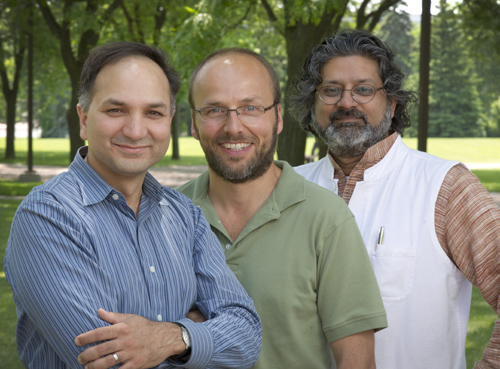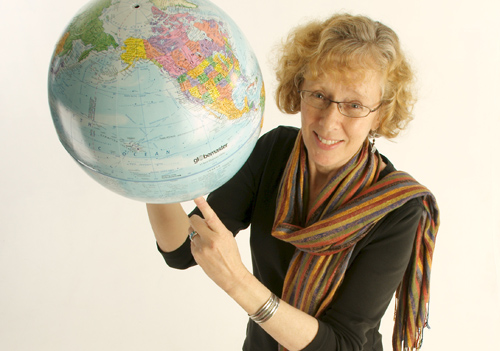
It has fed people for centuries, especially in dry parts of Asia and Africa. It’s more nutritious than rice. But especially in parts of India, this staple cereal crop has fallen out of favour, with potentially dire consequences for consumers’ health and farmers’ livelihoods. Now University of Guelph researchers hope their role in an international multi-million-dollar research project begun this spring will help restore millet to farm fields and kitchens in South Asia.
The U of G team − involving faculty in the Ontario Agricultural College, the College of Biological Science, and the College of Social and Applied Human Sciences − will receive about $267,000 under the project, mostly to be spent in India, says food scientist Koushik Seetharaman.
He’s working with Profs. Manish Raizada, Plant Agriculture; Sally Humphries, Sociology and Anthropology; and Steve Newmaster, Integrative Biology.
The money will come through the Canadian International Food Security Research Fund (CIFSRF) from the International Development Research Centre and the Canadian International Development Agency. That $3.5-million fund aims to increase production and consumption of minor millets, pulses and oil seeds in parts of India, Nepal and Sri Lanka.
The project is headed by Kirit Patel, professor in international development studies at Canadian Mennonite University in Winnipeg.
Among variants of this cereal crop, pearl millet is the most widely known, not just in Asia but also in Canada. For instance, Seetharaman regularly uses millet from a bulk food store to make porridge at home; Newmaster favours it in his cereal and salad.
But the U of G team is looking at “minor” millets, which are little-studied and lesser known here in Canada.
Minor millets – including barnyard, proso, foxtail, kodo and little millet – are nutritious, can tolerate difficult growing conditions and store easily. For many indigenous people in South Asia, especially India, they’re a dietary staple. But that’s changing, for several reasons.
Millet takes a lot of muscle power to harvest and thrash, and people – mostly women – are more reluctant to spend hours pounding grains. And as the Indian middle class grows, tastes are changing. Millet is increasingly considered a “lower-class” food, says Seetharaman. “Even rural farmers are susceptible to that perception and don’t want to eat it.”
Farm policies further complicate the problem, as well as introducing new health concerns. Rice is subsidized by the state and costs consumers much less than millet. But milled rice is less nutritious, says Seetharaman, and it’s starchier. That makes it a possible culprit in rising diabetes rates in India.
Learning more about millet starch will be part of his broader role in analyzing the crop’s overall nutrient composition. Scientists lack solid nutritional information about millet, including data to support or disprove perceptions about its benefits.
For instance, various kinds of millet are claimed to leave consumers feeling fuller or feeling more energetic. Lab studies may help to substantiate such claims, says Seetharaman. (He’s also studying millet digestibility in a separate project with colleague Massimo Marcone, funded by the Ontario Ministry of Agriculture, Food and Rural Affairs.)
In the CIFSRF project, Newmaster will compare traditional and scientific knowledge by looking at plant genetics. He’ll use DNA barcoding in U of G’s Biodiversity Institute of Ontario to help distinguish among millet species. As an ethnobotanist, he’s interested in seeing how scientific classification matches – or not – indigenous groupings of plants and their food, medicinal and ecological uses.
Working for two years with researchers at Guelph and in India, Newmaster has already co-authored one study of millet biodiversity accepted this spring by the Journal of Ethnobiology. That study found indigenous peoples in southern India recognize 18 kinds of millet, for instance, within only five species distinguished by western scientists.
Raizada has looked at corn genetics and ways to help farmers grow crops more economically. Now he hopes to help millet farmers use less labour and reduce costs even while improving production. He aims to develop sustainable agriculture kits containing seeds and management tools for farmers, not just in India but elsewhere. “The project is about millets for Asia, but I want to see how it can be applied to other parts of the world,” he says, notably many African countries.

For this project, Humphries plans to apply lessons from her studies of participatory plant breeding during the past decade in Honduras. There, she has helped farmers to select and cross plants for their particular growing conditions rather than rely on ill-adapted material from breeders.
In Asia, farmers will select from existing millet varieties rather than breed plants. But, says Humphries, “the goals are the same: putting farmers in the driving seat, rather than plant breeders.”
She also hopes to improve women’s working conditions – a key challenge. “Unless we can lighten women’s load, we will not be able to increase the production and consumption of millets. They involve too much drudgery, both in the fields and post-harvest.”
The Guelph team will focus mostly on India. Faculty members and grad students will travel between the two countries, says Seetharaman. “It’s significant high-quality personnel training.”
The larger CIFSRF project also involves researchers from McGill University as well as groups in Sri Lanka and Nepal.